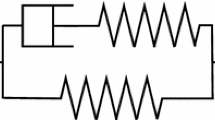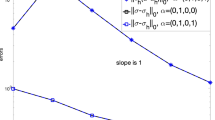Abstract
We provide a new mixed finite element analysis for linear elastodynamics with reduced symmetry. The problem is formulated as a second order system in time by imposing only the Cauchy stress tensor and the rotation as primary and secondary variables, respectively. We prove that the resulting variational formulation is well-posed and provide a convergence analysis for a class of \({\mathrm {H}}(\mathop {{\mathrm {div}}}\nolimits )\)-conforming semi-discrete schemes. In addition, we use the Newmark trapezoidal rule to obtain a fully discrete version of the problem and carry out the corresponding convergence analysis. Finally, numerical tests illustrating the performance of the fully discrete scheme are presented.
Similar content being viewed by others
References
Arnold, D.N., Brezzi, F., Douglas, J.: PEERS: A new mixed finite element method for plane elasticity. Japan J. Appl. Math. 1, 347–367 (1984)
Arnold, D.N., Falk, R.S., Winther, R.: Mixed finite element methods for linear elasticity with weakly imposed symmetry. Math. Comp. 76, 1699–1723 (2007)
Arnold, D.N., Lee, J.J.: Mixed methods for elastodynamics with weak symmetry. SIAM J. Numer. Anal. 52, 274–2769 (2014)
Bécache, E., Joly, P., Tsogka, C.: A new family of mixed finite elements for the linear elastodynamic problem. SIAM J. Numer. Anal. 39, 2109–2132 (2002)
Boffi, D., Brezzi, F., Fortin, M.: Reduced symmetry elements in linear elasticity. Comm. Pure Appl. Anal. 8, 1–28 (2009)
Boulaajine, L., Farhloul, M., Paquet, L.: A priori error estimation for the dual mixed finite element method of the elastodynamic problem in a polygonal domain II. J. Comput. Appl. Math. 235(5), 1288–1310 (2011)
Boffi, D., Brezzi, F., Fortin, M.: Mixed Finite Element Methods and Applications. Springer Series in Computational Mathematics, vol. 44. Springer, Heidelberg (2013)
Cockburn, B., Gopalakrishnan, J., Guzmán, J.: A new elasticity element made for enforcing weak stress symmetry. Math. Comp. 79, 1331–1349 (2010)
Douglas Jr., J., Gupta, C.P.: Superconvergence for a mixed finite element method for elastic wave propagation in a plane domain. Numer. Math. 49, 189–202 (1986)
Evans, L.C.: Partial Differential Equations. Second edition. Graduate Studies in Mathematics, vol 19. American Mathematical Society, Providence, RI (2010)
Farhloul, M., Fortin, M.: Dual hybrid methods for the elasticity and the Stokes problems: a unified approach. Numer. Math. 76, 419–440 (1997)
Gatica, G.N.: Analysis of a new augmented mixed finite element method for linear elasticity allowing \(\mathbb{RT}_0-{\mathbb{P}}_1-{\mathbb{P}}_0\) approximations. M2AN. Math. Model. Numer. Anal. 40, 1–28 (2006)
Gatica, G.N.: A simple introduction to the mixed finite element method. Theory and Applications. Springer Briefs in Mathematics. Springer, Cham (2014)
Gopalakrishnan, J., Guzmán, J.: A second elasticity element using the matrix bubble. IMA J. Numer. Anal. 32, 352–372 (2012)
Hiptmair, R.: Finite elements in computational electromagnetism. Acta Numerica 11, 237–339 (2002)
Logg, A., Mardal, K.-A., Wells, G.N., et al.: Automated Solution of Differential Equations by the Finite Element Method. Springer, Berlin (2012)
Makridakis, ChG: On mixed finite element methods for linear elastodynamics. Numer. Math. 61, 235–260 (1992)
Meddahi, S., Mora, D., Rodríguez, R.: Finite element spectral analysis for the mixed formulation of the elasticity equations. SIAM J. Numer. Anal. 51, 1041–1063 (2013)
Renardy, M., Rogers, R.: An introduction to Partial Differential Equations. Texts in Applied Mathematics, vol. 13. Springer, New York (2004)
Roubíček, T.: Nonlinear Partial Differential Equations with Applications. 2nd edition. International Series of Numerical Mathematics, vol. 153. Birkhuser/Springer Basel AG, Basel (2013)
Stenberg, R.: A family of mixed finite elements for the elasticity problem. Numer. Math. 53, 513–538 (1988)
Author information
Authors and Affiliations
Corresponding author
Additional information
This work was partially supported by CONICYT-Chile through BASAL project CMM, Universidad de Chile; by project Anillo ACT1118 (ANANUM), Centro de Investigación en Ingeniería Matemática (CI\(^2\)MA), Universidad de Concepción; and by the Ministery of Education of Spain through the project MTM2013-43671-P.
Rights and permissions
About this article
Cite this article
García, C., Gatica, G.N. & Meddahi, S. A New Mixed Finite Element Method for Elastodynamics with Weak Symmetry. J Sci Comput 72, 1049–1079 (2017). https://doi.org/10.1007/s10915-017-0384-0
Received:
Revised:
Accepted:
Published:
Issue Date:
DOI: https://doi.org/10.1007/s10915-017-0384-0




